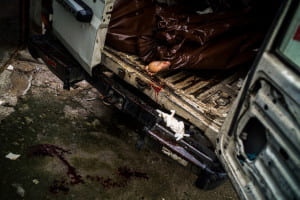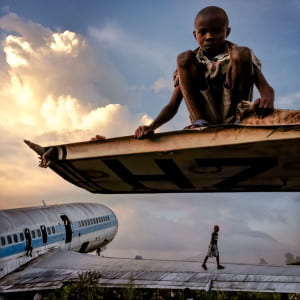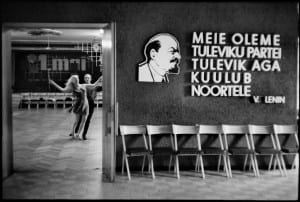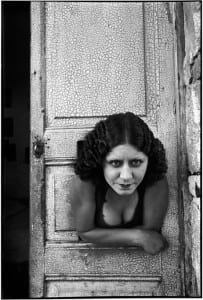The Magnum collective overall represents a vast variety of photos which differ not only in style, but content. Magnum’s front-page photo collections demonstrate the collective’s ability to be in touch with current events, exemplified through pieces like, “Syrian Refugees in the US”, “Kurdish Offensive in Sinjar”, and “Paris attacks”. At the same time, Magnum also seems to be interested in smaller scale occurrences that still resonate with relevant themes like portfolios covering a “Gay Synagogue in New York”, and “Unselfies”, a series which photographer Alex Soth takes the conventional selfie and distorts his own face. Thematically, Magnum covers a diverse range of topics, from the serious issues of global warming, child labor, September 11th, to topics like The Laugh, Creative Spirit, or extreme sports. All of these photos are compiled by a diverse group of contributors currently stationed around the world, from John Vink, based in Cambodia, to Michael Subotzky, based in South Africa, to Alec Soth, based in Minnesota. To that, most current photos featured on the website are in color, as opposed to the black and white “standard” that Magnum’s founders accepted.
Regarding the two photographers in focus, I chose Henri Cartier-Bresson, and Michael Christopher Brown. I was interested in viewing the work of Cartier-Bresson since he’s one of the founding members of Magnum, additionally because he mentioned that he disliked the use of color film. I thought that it would be interesting to see his use of light and contrast in his photos in order to make a good composition. In my opinion, it is harder to create a more compelling photo in black and white since grey-tones can often blend together and lose contrast, creating an uninteresting photo. In contrast, the second photographer I chose to focus on is Michael Christopher Brown, since his work is more current and he produces work in color. His series, “Honduras, Deported from the US” was featured in the “Latest Stories” section of the website and I was interested in his use of saturated color pictures, as well as his portrayal of the topic itself.
The first photo by Cartier-Bresson is from his Soviet Union portfolio. The photo was taken in Talinn, Estonia in 1973, and the image is captioned, “Cellulos industry. Training for dance championship.” The composition of the photo presents two focuses—a couple ballroom dancing behind a doorway in the left-third of the photo, and a quote from Vladimir Lenin facing toward the viewer which takes up the right two-thirds of the composition. This quote, which partially translates to, “We are the future of the party” serves as communist propaganda. Similarly, it is set alongside a series of empty chairs, which hints at a more common portrayal of the USSR from a Western perspective. Western media portrayal of Cold War-era USSR is one that reflects a bleak lifestyle under an oppressive regime. To that, glimmers of everyday life were not the primary focus of the Western media. While quality of life was arguably poor, Cartier-Bresson’s photo depicts a glimpse into the leisure-aspect of this era, a notion that is often looked over.
Cartier-Bresson’s second photo in focus is from his Mexico portfolio, taken in Mexico City 1934. Its caption states, “Prostituées. Calle Cuauhtemoctzin”. The photo depicts a portrait of a prostitute in Mexico City leaning out of a cutout doorway. The older building with its cracked-paint doorway can be juxtaposed to the young woman, whose eyes lie just above and to the right of Cartier-Bresson. The subject of the photo itself is interesting in that she is clearly a young woman, but her pursed lips and and almost furrowed brows indicate hardship. Similarly, there is a darkness under the woman’s eyes that age her. At the same time, her hair is made-up and she wears a “revealing” top, which indicates that she is soliciting customers. Cartier-Bresson creates a composition that lets the viewer draw their eyes toward the woman’s face, as opposed to her other features. Cartier-Bresson chose to capture everyday life, but his choice to photograph a prostitute is unconventional, and serves as a somewhat unspoken approach to the on-goings of a city.
The first piece I chose from Michael Christopher Brown is from his featured portfolio, “Honduras, Deported From the US”. The photo was taken in San Pedro Sula in 2015, and is captioned, “Plagued by gang violence, the city has had the highest murder rate in the world for the last four years.” The photo itself depicts a body wrapped in plastic inside of a bloody van. The photo’s colors are very saturated, and the vignette around the borders of the composition draw the eye straight toward the center, where a bloody foot sticks out of a body bag. The use of color as opposed to black and white makes the photo more powerful, since blood is present. Brown’s photo series follows the life of a man who was deported from the US as he returns back to Honduras. To that, while Brown’s photo in focus does not depict the deported man himself, it is telling to the dangerous lifestyle that he faces as a result of being deported. While the photo is not opinionated, its imagery helps the viewer to not only empathize with the deported man, but to form an opinion on deportation itself. Deportation in the US is often times viewed as an implication-free act, but Brown’s photo shines a light on to the issue.

HONDURAS. San Pedro Sula. 2015. Plagued by gang violence, the city has had the highest murder rate in the world for the last four years.
Lastly, the second piece from Michael Christopher Brown drew me in because of its composition. The photo was taken in Goma, Congo on December 14, 2012. It is captioned, “Abandoned planes are a common site at airports in Africa”. The photo functions on two different levels. First, it is a portrait of a young boy who sits a top of a rusted plane part. The warm colors draw him forward in the composition, so the eye is guided there at first. Secondly, below the boy is an abandoned airplane. Upon further inspection, children hang from the plane’s windows and another boy walks alongside the wing. The sky takes up another portion of the photo, and since its composition fits inside a square, every portion of the photo has something going on. Brown’s use of color allows the eye to travel almost in a circular motion around the photo, starting from the top boy, to the clouds, to the plane. With that said, Brown notes that “One is generally prohibited from photographing this airport but […] nobody was guarding this section of the airport. Children guided [him] through the planes”. The photo is beautiful in itself, but knowing the context is important simply due to the danger that was associated with the makings of this picture.

CONGO. Goma. December 14, 2012. Abandoned planes are a common site at airports in Africa. At Goma Airport, in the Democratic Republic of Congo, planes left due to wars and volcanic eruptions over the past two decades have become a playground for street children, some of whom sell the parts which are made into stoves and other items to be sold on the streets of Goma.
One is generally prohibited from photographing this airport but in mid-December, 2012, after the M23 rebel force which occupied Goma left and before the FARDC (military of the D.R.C.) returned to the city, a security vacuum meant that nobody was guarding this section of the airport. Children guided me through the planes, which were later discussed by my Congolese fixer:
“In January of 2002, the volcano (Nyiragongo, just outside Goma) exploded and the lava blocked the planes. I helped move this plane after I and many of my friends living near the airport lost our homes to lava, on the first day of the eruption. On the second day, we saw the lava moving towards the planes. I and others were just watching the lava flow getting closer to the planes and we decided to move one of them, this newer one. There were at least a hundred people there pushing the plane for about 300 meters. A friend mine, who was there and whose house was also destroyed, had a childhood dream to be a pilot. But his parents were too poor and all the schools were expensive, so he could not hold onto that dream. He forgot about it, but then on that day, when we needed to move the plane, he told me to help him inside so he might steer it! We all pushed the plane as my friend waved his arm out the window, in the cockpit. We then climbed in the plane and saw the lava flowing down the volcano and into town.”


Recent Comments